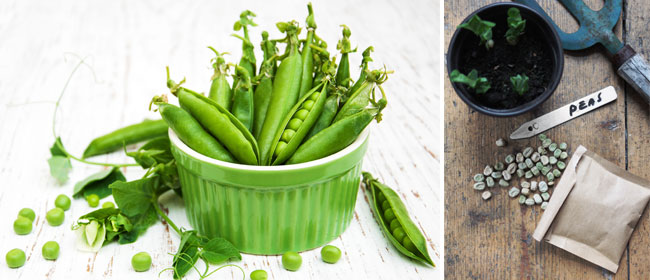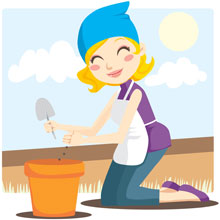By Jane
Make Life Easy
Have you ever seen fresh peas for sale? I’m sure they’re out there, but in my urban surrounds I’ve never spotted a single one. For sale, that is. Turns out, only about 5 per cent of the world’s peas grown are sold fresh; the rest are either frozen or canned.
But you can grow your own – and why not? Peas are quick-growing and easy too, and a freshly grown pea, just like sweet corn, will be sweeter for it. They’re cool season plants, so they grow best when started in spring or autumn.
As a member of the legume family, peas can actually improve soil. They pull nitrogen out of the air and store it in tiny nodules along their root system. Because of that, it’s better to dig your plants into the soil after harvesting has finished rather than pull them out, so that the nitrogen-rich roots can decompose right there in the ground and release the vital nutrient back into the soil.
Planting
 Select a sunny location (at least six hours of sun) and consider what’s in the garden nearby. Most pea varieties will grow tall, some up to 2m (79 inches), and will shade any nearby plants. Tall growing varieties will also need poles or trellises for support.
Select a sunny location (at least six hours of sun) and consider what’s in the garden nearby. Most pea varieties will grow tall, some up to 2m (79 inches), and will shade any nearby plants. Tall growing varieties will also need poles or trellises for support.
A moist but well-draining soil is best. Work compost into your soil prior to planting to prevent compaction, improve drainage and feed the soil, but don’t add nitrogen. Since peas pull nitrogen from the air and store it in their roots, they already have plenty. If you add nitrogen the plants will produce more leaves and fewer peas. A handful of superphosphate is beneficial though. Mix it into the soil, as young pea roots may be damaged by direct contact.
The best planting conditions for peas are when soil temperatures remain above 7deg C (45deg F), although seeds will germinate in soil temperatures as low as 4deg (39deg F). If need be, use a tunnel house or cloche to get your peas off to a good start. If the ground is constantly wet and cold, the peas will rot.
Create rows 8cm (3 ¼ inches) deep and 60cm (24 inches) apart and sow seeds directly into the soil. Cover lightly and water in well. Then sow successively. Plant peas every three weeks up until around October (mid Spring, if planted late winter-early spring) so you can have an extended harvest. Peas will stop producing when the weather starts to heat up in summer.
Caring for plants
Peas require little care. Water during times of drought, skip subsequent fertilising, and stake if necessary. Watch out for slugs and snails, which like to munch on emerging pea shoots. Birds may also pluck out young seedlings, so keep watch and cover if necessary.
Pick peas in the early morning as soon as the dew has dried; that’s the time when they are at their crispest. Pick pea pods daily to encourage more pea production.
 My Favourites
My Favourites













Speak Your Mind